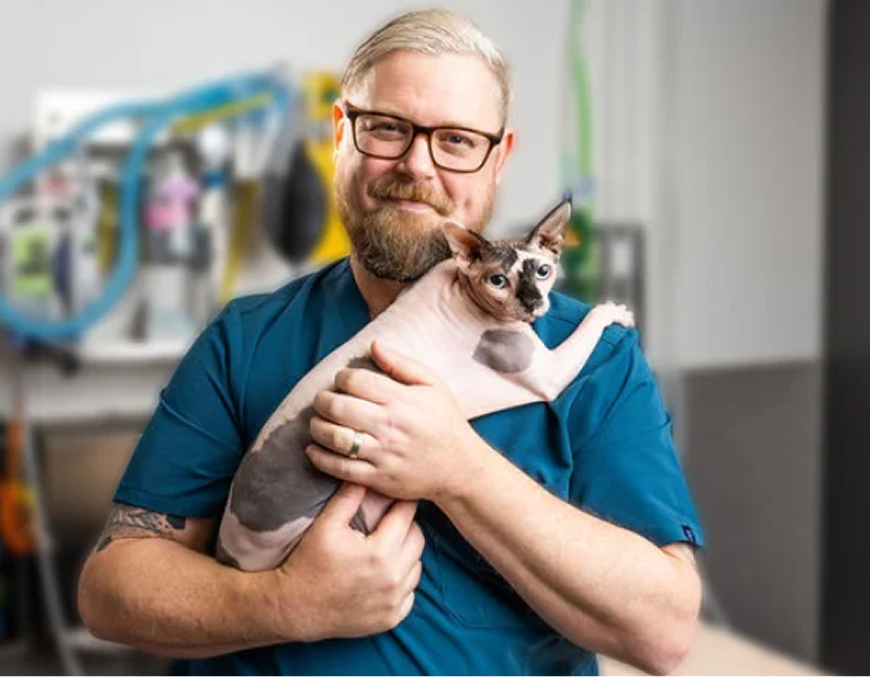Removing complex teeth safely and with minimal impact.
Linguoverted canine teeth in pets, also known as base narrow or inverted canines, occur when the lower canine teeth are positioned too inwardly, striking the soft tissue of the upper mouth. This misalignment can cause significant discomfort and trauma, potentially leading to serious conditions like oronasal fistulas, where a hole forms between the mouth and the nasal cavity.

So, your dog has teeth in the wrong spot…
Linguoverted canine teeth (base narrow or inverted canines) is one of the most common orthodontic concerns we see in veterinary dental practice.
The condition occurs when the mandibular canines are misaligned, striking the soft tissue of the maxilla and causing trauma. If untreated, this can lead to severe damage, including oronasal fistulas, often due to skeletal issues like Class 2 Malocclusion, a narrow mandible or retained deciduous teeth.
This condition causes chronic oral pain if left untreated and can be managed with treatment tailored to the patient’s age, underlying cause and tooth position.
“Linguoverted (base-narrow) canine teeth are a common orthodontic concern—when left to strike the roof of the mouth, they can cause ulcers, severe pain and may even create an opening into the nasal cavity.”

6-12 Weeks Old
At this age, if the lower deciduous canines are traumatising the maxillary mucosa, intervention is necessary. These sharp teeth cause pain every time the puppy closes its mouth. We recommend extracting the deciduous mandibular canines to alleviate this discomfort. However, this must be done carefully to avoid damaging the developing permanent teeth.
This procedure is often palliative, as the permanent teeth are likely to erupt in the same or a similar position, requiring further intervention. In some cases deciduous canine extractions relieve ‘dental interlock’ allowing the mandible to ‘catch up’ to the maxilla and the permanent teeth to erupt in a normal position.

5-6 months old
At this age, the permanent canine teeth should be erupting. Firstly, it is ESSENTIAL that the deciduous canines (both maxillary and mandibular) are not persistent. Retention occurs when the deciduous teeth remain present alongside the erupting adult teeth. This doesn’t require the adult tooth to be fully erupted—if the deciduous tooth is firm and the adult tooth is just starting to emerge, the deciduous tooth needs removal ASAP. Retention of the deciduous tooth can force the permanent tooth into a worse position, exacerbating the malocclusion.
If the deciduous mandibular canine teeth are persistent, the permanent tooth will erupt lingually, worsening the linguoversion. Persistent maxillary canine teeth will cause the permanent tooth to erupt in front of the deciduous tooth, narrowing the space between the maxillary third incisor and canine teeth, blocking the mandibular canines from erupting into a non-traumatic position.
Removing the persistent deciduous tooth often allows the erupting tooth to shift into the extraction site, leading to a more appropriate position. During the eruption of the lower canines, the teeth are not yet “set” in the bone and can be guided by external forces. Some animals respond well to oral ball play, using appropriately sized firm rubber toys or balls.
Frequent play, for 15 minutes three times a day, can apply enough lateral pressure to move the lower canines into a more normal position during this period.
In some cases, a more proactive approach is necessary, and early orthodontic intervention may be recommended. This can include a gingivoplasty procedure or the placement of crown extensions. Gingivoplasty alters the shape of the diastema (space) between the upper third incisor and upper canine, creating a “ramp” that guides the erupting lower canine into the correct position. Crown extensions help guide the teeth into a more appropriate position by tipping the canines. Though not always applicable, if successful, this is usually the final treatment required.
Selective extractions of minor teeth may also be performed in some patients to create space for the permanent mandibular canines to erupt correctly.
“Early extraction of baby canine teeth—when performed carefully—can relieve discomfort and may guide adult teeth into a healthier position without further intervention.”

8 months old
If previous interceptive interventions have been unsuccessful or patients were not suitable candidates, definitive treatment can begin at 7-8 months of age.
For many patients where orthodontic treatment is impractical or impossible, a bilateral height reduction and vital pulpotomy may be appropriate. We prefer to perform this procedure at around 8 months of age when possible.
This procedure involves reducing the height of the mandibular canines to approximately the level of the mandibular incisors, preventing contact with other tissues in the mouth. It exposes the pulp chamber, which must be protected with restorations or fillings. Ongoing dental radiographs are required for follow-up throughout the patient’s lifetime.
Alternatively, some patients are candidates for an inclined plane, an orthodontic device attached to the upper jaw between the upper canines and incisors. This acrylic device guides the lower canines into their correct positions by making contact with the device. Initially, the dog cannot fully close its mouth, but the teeth will shift labially over a period of about 4 weeks.

This method is preferred over bilateral height reduction due to its lower risk of tooth damage and minimal long-term follow-up requirements.
Extraction of the lower canines is another option for patients with linguoverted mandibular canine teeth. This procedure provides relief from discomfort and is generally preferable to inaction.
While it requires no long-term follow-up, it may lead to cosmetic changes, including:
- Tongue protrusion from the mouth (rare)
- Thinning of the front of the lower jaw
- Regression in the length of the lower jaw (if incisor teeth are also extracted)
- A small risk of jaw fracture during extraction
It is important to know that we can always make your dog comfortable. How we achieve that is slightly different for each patient, but regardless of how we get there, improving comfort and quality of life is always our primary aim.














